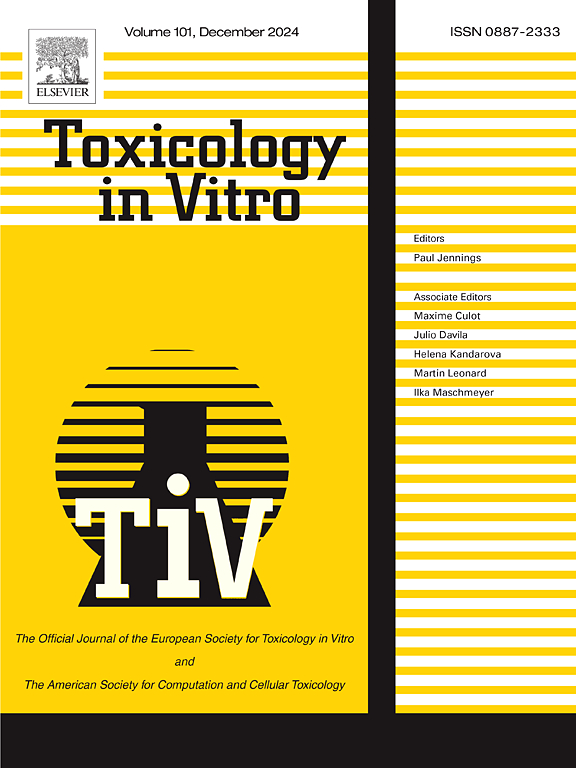Anti-androgenetic effect of diphlorethohydroxycarmalol on testosterone-induced hair loss by inhibiting 5α-reductase and promoting Wnt/β-catenin signaling pathway in human dermal papilla cells
IF 2.6
3区 医学
Q3 TOXICOLOGY
引用次数: 0
Abstract
Diphlorethohydroxycarmalol (DPHC), a marine phlorotannin compound derived from the brown alga Ishige okamurae, has been known to have a variety of biological effects. Recently, marine resources have been highlighted by their effects on ameliorating alopecia and related hair loss. Therefore, this study aimed to investigate the potential of DPHC isolated from I. okamurae as a hair loss treatment through examination of its anti-androgenic alopecia effects. Molecular docking analysis predicted that DPHC can be used as a 5α-reductase inhibitor superior to finasteride, which has traditionally been used as an anti-androgenic alopecia agent. In addition, DPHC significantly inhibited 5α-reductase activity in dihydrotestosterone (DHT)-treated human dermal papilla (HDP) cells, and downregulated hair growth inhibitor proteins such as AR, DKK1, TGF-β1, and IL-6. Moreover, DPHC treatment remarkably upregulated both the phosphorylation levels of GSK3β and expression levels of β-catenin in DHT-treated HDP cells, confirming the effects of DPHC on activating the Wnt/β-catenin signaling pathway. Therefore, these findings suggest that DPHC has a significant potential to prevent androgenic alopecia by promoting hair growth and preventing hair loss.
二酚乙羟卡麦醇通过抑制人真皮乳头细胞5α-还原酶和促进Wnt/β-catenin信号通路对睾酮诱导脱发的抗雄激素作用
二苯甲氧羟基甘油醇(DPHC)是一种从褐藻石重冈藻中提取的海洋苯丹素化合物,具有多种生物效应。近年来,海洋资源在改善脱发和相关脱发方面的作用备受关注。因此,本研究旨在通过检测冈村一株DPHC抗雄激素性脱发的作用,探讨其治疗脱发的潜力。分子对接分析预测DPHC可以作为5α-还原酶抑制剂,优于非那雄胺,后者传统上被用作抗雄激素性脱发药物。此外,DPHC显著抑制二氢睾酮(DHT)处理的人真皮乳头(HDP)细胞5α-还原酶活性,下调毛发生长抑制蛋白AR、DKK1、TGF-β1、IL-6。此外,DPHC处理显著上调了dht处理的HDP细胞中GSK3β的磷酸化水平和β-catenin的表达水平,证实了DPHC对激活Wnt/β-catenin信号通路的作用。因此,这些研究结果表明,DPHC通过促进头发生长和防止脱发,具有显著的预防雄激素性脱发的潜力。
本文章由计算机程序翻译,如有差异,请以英文原文为准。
求助全文
约1分钟内获得全文
求助全文
来源期刊

Toxicology in Vitro
医学-毒理学
CiteScore
6.50
自引率
3.10%
发文量
181
审稿时长
65 days
期刊介绍:
Toxicology in Vitro publishes original research papers and reviews on the application and use of in vitro systems for assessing or predicting the toxic effects of chemicals and elucidating their mechanisms of action. These in vitro techniques include utilizing cell or tissue cultures, isolated cells, tissue slices, subcellular fractions, transgenic cell cultures, and cells from transgenic organisms, as well as in silico modelling. The Journal will focus on investigations that involve the development and validation of new in vitro methods, e.g. for prediction of toxic effects based on traditional and in silico modelling; on the use of methods in high-throughput toxicology and pharmacology; elucidation of mechanisms of toxic action; the application of genomics, transcriptomics and proteomics in toxicology, as well as on comparative studies that characterise the relationship between in vitro and in vivo findings. The Journal strongly encourages the submission of manuscripts that focus on the development of in vitro methods, their practical applications and regulatory use (e.g. in the areas of food components cosmetics, pharmaceuticals, pesticides, and industrial chemicals). Toxicology in Vitro discourages papers that record reporting on toxicological effects from materials, such as plant extracts or herbal medicines, that have not been chemically characterized.
 求助内容:
求助内容: 应助结果提醒方式:
应助结果提醒方式:


